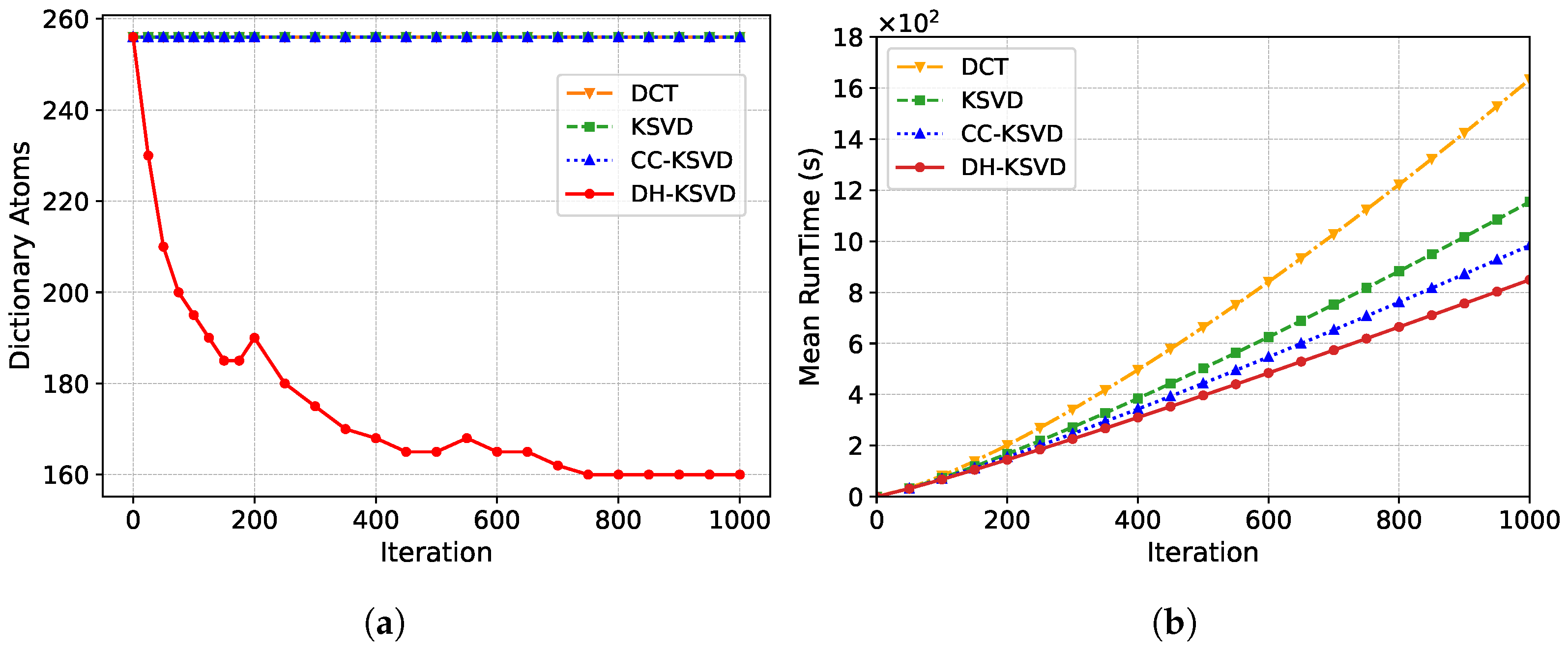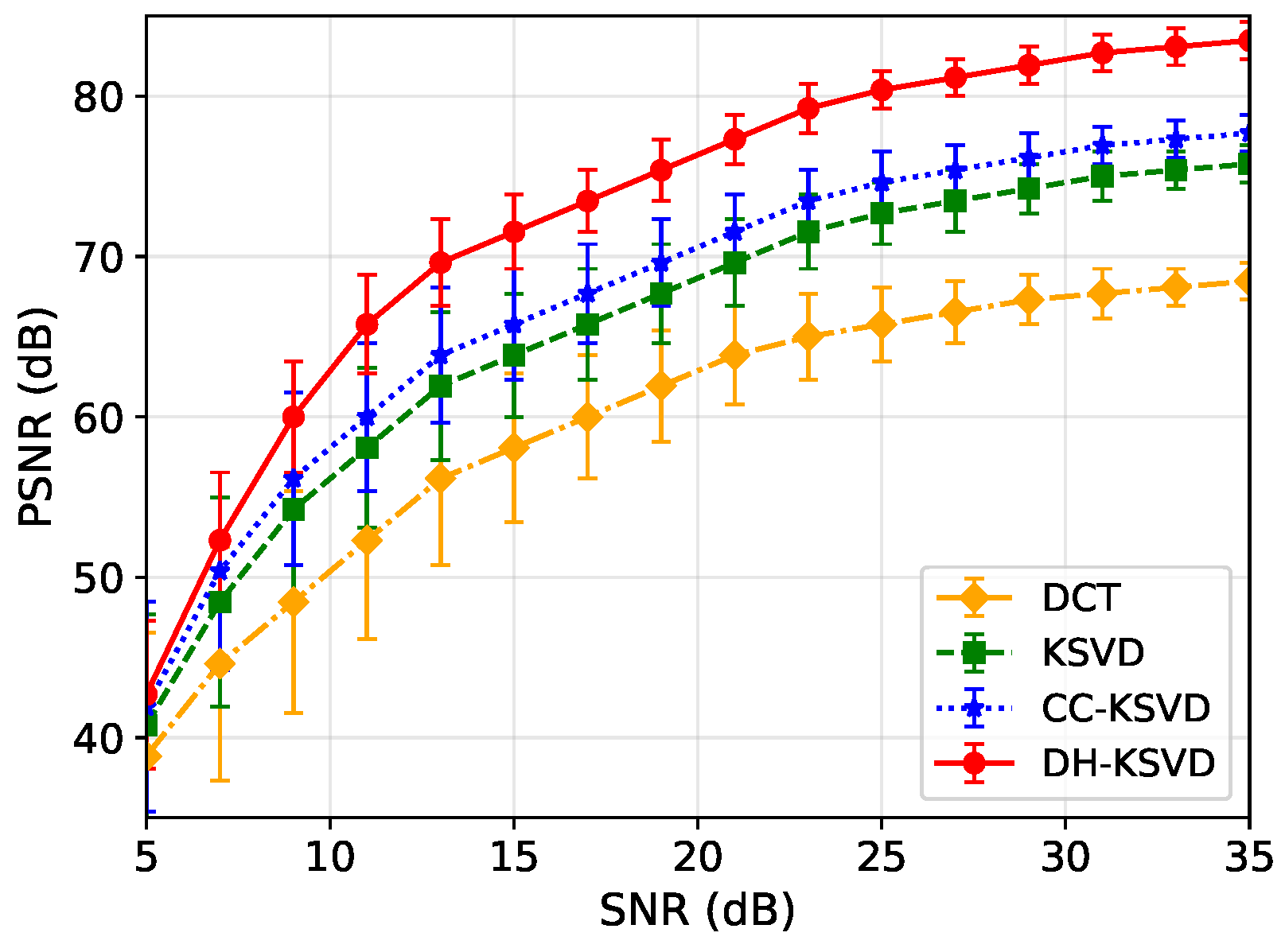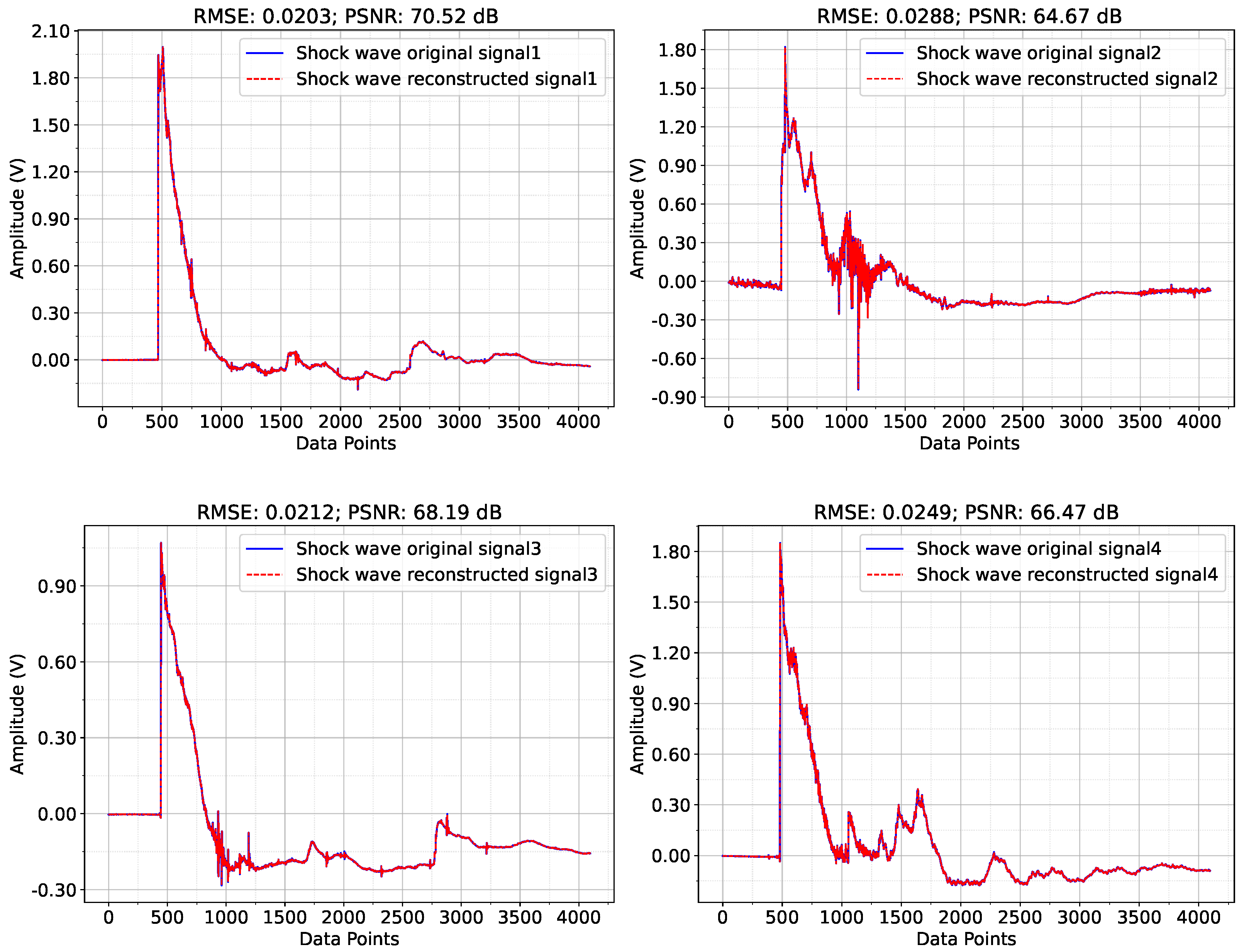A DH-KSVD Algorithm for Efficient Compression of Shock Wave Data
Abstract
1. Introduction
- A dynamic pruning mechanism is introduced to evaluate the importance of atoms based on their contribution. By adaptively removing redundant atoms while supplementing residual features, the compactness of the dictionary is enhanced and training efficiency is improved.
- A hybrid sparse coding strategy is designed to integrate the strict sparsity of -based Orthogonal Matching Pursuit (OMP) with the noise robustness of -based Least Absolute Shrinkage and Selection Operator (LASSO), dynamically balancing their weights to improve coding quality and reconstruction stability.
- The proposed DH-KSVD algorithm achieves superior performance in both training efficiency and reconstruction accuracy under more aggressive compression, especially in noisy environments, offering an effective solution for transient signal compression such as shock waves.
2. Theoretical Analysis
2.1. Shock Wave Characteristics
2.2. Compressive Sensing Theory
2.3. KSVD Sparse Model
3. Improved Algorithm DH-KSVD
3.1. Dynamic Dictionary Pruning Mechanism
3.2. Hybrid Sparse Constraint Strategy
3.3. Algorithm Description of DH-KSVD
| Algorithm 1 DH-KSVD algorithm |
| Input:, , ∂, , , , , Q, Output:,
|
3.4. Application of DH-KSVD in CS Framework
3.4.1. A Compressed Sensing Framework Based on DH-KSVD
3.4.2. Algorithm Complexity Analysis
4. Experimental Results and Analysis
4.1. Experimental Conditions Setting
4.2. Algorithm Performance Analysis
4.2.1. Efficiency Analysis of Training Dictionary
4.2.2. Robustness Analysis of Algorithms
4.2.3. Performance Analysis of CS Reconstruction Algorithm
4.3. Ablation Experiment
5. Discussion
- Enhanced efficiency and practicality for transient signal compression: the core of the DH-KSVD algorithm lies in its “offline training, online compression” paradigm. The dictionary learning process itself is computationally intensive and performed offline, while the resulting highly compact and expressive dictionary enables efficient online compression on resource-constrained edge devices. This design makes the method particularly suitable for practical applications such as destructive testing at sea, where megahertz-level sampling generates massive data volumes but transmission bandwidth and storage space are extremely limited. Compared to the KSVD algorithm, dictionary training time is significantly reduced (by 31%), while maintaining excellent reconstruction quality even at high compression ratios. This directly enhances the feasibility of long-term, multi-channel shock wave monitoring.
- Robustness in noisy environments: the hybrid sparse constraint strategy combines the precise atom selection of -OMP with the noise-resistant coefficient optimization of -LASSO, endowing the DH-KSVD algorithm with enhanced resistance to noise interference. Experimental results confirm that the DH-KSVD algorithm consistently achieves higher values compared to various benchmark algorithms, demonstrating particularly outstanding performance in low- scenarios. This robustness is crucial for shock wave measurements, which are frequently impacted by environmental and system noise contamination.
- The performance comparisons in this work are conducted within the traditional sparse representation framework. A valuable future direction is to benchmark DH-KSVD against modern reconstruction paradigms, such as reweighted- or deep-learning-based methods, to further validate its generalization capability and robustness across diverse signal conditions.
- The current version of the DH-KSVD algorithm is designed to handle additive noise but does not explicitly address the challenge of missing samples or structurally corrupted data, which is a common issue in harsh acquisition environments. Future work will therefore focus on enhancing the framework’s resilience to such forms of data imperfection. Promising research directions include the integration of robust regression techniques capable of decomposing a signal into clean and sparse error components, as well as the development of preprocessing strategies based on data imputation or inpainting to effectively compensate for packet loss or sensor failures.
- Although the online compression stage is designed for efficient operation, further optimization is needed to achieve real-time processing on low-power embedded platforms. Future work will focus on the co-design of algorithms and hardware, exploring strategies such as dictionary quantization and fixed-point computation implementation. This approach will maximize the algorithm’s practical value in extreme edge computing scenarios.
- The values of hyperparameters and were determined through systematic analysis on an independent validation set. Although the proposed thresholding method has demonstrated effectiveness in the current task, optimal threshold selection remains a challenging and highly context-dependent problem. Future research will explore and integrate adaptive thresholding techniques from other signal processing domains. For instance, threshold determination for RD-HR maps in High-Frequency Surface Wave Radar systems presents a similar challenge, where recent data-driven strategies including geometry-based and experimentally derived adaptive algorithms [25,26] offer promising extensions to the current framework. Incorporating such approaches is expected to enhance the method’s robustness, automation capability, and applicability across diverse scenarios.
6. Conclusions
Author Contributions
Funding
Institutional Review Board Statement
Informed Consent Statement
Data Availability Statement
Conflicts of Interest
References
- Ma, X.J.; Kong, D.R.; Shi, Y.C. Measurement and analysis of shock wave pressure in moving charge and stationary charge explosions. Sensors 2022, 22, 6582. [Google Scholar] [CrossRef] [PubMed]
- You, W.B.; Ding, Y.H. W-MOPSO in adaptive circuits for blast wave measurements. IEEE Sens. J. 2021, 21, 9323–9332. [Google Scholar] [CrossRef]
- Mou, Z.L.; Niu, X.B.; Wang, C. A precise feature extraction method for shock wave signal with improved CEEMD-HHT. J. Ambient. Intell. Humaniz. Comput. 2020, 1–12. [Google Scholar] [CrossRef]
- Ding, Y.H.; You, W.B. Sensor placement optimization based on an improved inertia and adaptive particle swarm algorithm during an explosion. IEEE Access 2020, 8, 207089–207096. [Google Scholar] [CrossRef]
- Shi, Y.M.; Bai, S.H.; Wei, X.Y.; Gong, R.H.; Yang, J.L. Lossy and lossless (l2) post-training model size compression. In Proceedings of the IEEE/CVF International Conference on Computer Vision, Paris, France, 2–6 October 2023; pp. 17546–17556. [Google Scholar]
- Sarker, P.; Rahman, M.L. A Huffman-based short message service compression technique using adjacent distance array. Int. J. Inf. Commun. Technol. 2024, 25, 118–136. [Google Scholar] [CrossRef]
- Hassan, A.; Javed, S.; Hussain, S.; Ahmad, R.; Qazi, S. Arithmetic N-gram: An efficient data compression technique. Discov. Comput. 2024, 27, 1. [Google Scholar] [CrossRef]
- Jrai, E.A.; Alsharari, S.; Almazaydeh, L.; Elleithy, K.; Abu-Hamdan, O. Improving LZW Compression of Unicode Arabic Text Using Multi-Level Encoding and a Variable-Length Phrase Code. IEEE Access 2023, 11, 51915–51929. [Google Scholar] [CrossRef]
- Matsumoto, N.; Mazumdar, A. Binary iterative hard thresholding converges with optimal number of measurements for 1-bit compressed sensing. J. ACM 2024, 71, 1–64. [Google Scholar] [CrossRef]
- Shi, L.; Qu, G.R. An improved reweighted method for optimizing the sensing matrix of compressed sensing. IEEE Access 2024, 12, 50841–50848. [Google Scholar] [CrossRef]
- Průša, Z.; Holighaus, N.; Balazs, P. Fast matching pursuit with multi-Gabor dictionaries. ACM Trans. Math. Softw. (TOMS) 2021, 47, 1–20. [Google Scholar] [CrossRef]
- Arya, A.S.; Mukhopadhyay, S. Adaptive sparse modeling in spectral & spatial domain for compressed image restoration. Signal Process. 2023, 213, 109191. [Google Scholar] [CrossRef]
- Sun, Y.B.; Long, H.W.; Zhao, S.Y.; Zhang, Y.; Zhu, J.N.; Yang, X.H.; Fu, L.B. In Situ Monitoring and Defect Diagnosis Method Based on Synchronous Compression Short-Time Fourier Transform and K-Singular Value Decomposition for Al-Carbon Fiber-Reinforced Thermoplastic Friction Stir Lap Welding. J. Mater. Eng. Perform. 2024, 34, 8388–8397. [Google Scholar] [CrossRef]
- Xie, M.L.; Ji, Z.X.; Zhang, G.Q.; Wang, T.; Sun, Q.S. Mutually exclusive-KSVD: Learning a discriminative dictionary for hyperspectral image classification. Neurocomputing 2018, 315, 177–189. [Google Scholar] [CrossRef]
- Abubakar, A.; Zhao, X.J.; Takruri, M.; Bastaki, E.; Bermak, A. A hybrid denoising algorithm of BM3D and KSVD for Gaussian noise in DoFP polarization images. IEEE Access 2020, 8, 57451–57459. [Google Scholar] [CrossRef]
- Jayakumar, R.; Dhandapani, S. Karhunen Loeve Transform with adaptive dictionary learning for coherent and random noise attenuation in seismic data. Sādhanā 2020, 45, 275. [Google Scholar] [CrossRef]
- Leal, N.; Zurek, E.; Leal, E. Non-local SVD denoising of MRI based on sparse representations. Sensors 2020, 20, 1536. [Google Scholar] [CrossRef]
- Ju, M.C.; Han, T.L.; Yang, R.K.; Zhao, M.; Liu, H.; Xu, B.; Liu, X. An adaptive sparsity estimation KSVD dictionary construction method for compressed sensing of transient signal. Math. Probl. Eng. 2022, 1, 6489917. [Google Scholar] [CrossRef]
- Si, W.J.; Liu, Q.; Deng, Z.A. Adaptive Reconstruction Algorithm Based on Compressed Sensing Broadband Receiver. Wirel. Commun. Mob. Comput. 2021, 1, 6673235. [Google Scholar] [CrossRef]
- Wang, H.Q.; Tang, Q.N.; Wang, Y.H.; Ren, S.L. Application of D-KSVD in compressed sensing based video coding. Optik 2021, 226, 165917. [Google Scholar] [CrossRef]
- Zhang, A.L.; Han, T.L. Application of Sparse Dictionary Adaptive Compression Algorithm in Transient Signals. In Journal of Physics: Conference Series; IOP Publishing: Bristol, UK, 2019; Volume 1229, p. 012048. [Google Scholar] [CrossRef]
- You, W.B.; Ding, Y.H.; Yao, Y. Static explosion field reconstruction based on the improved biharmonic spline interpolation. IEEE Sens. J. 2020, 20, 7235–7240. [Google Scholar] [CrossRef]
- Wen, J.M.; Li, C.H.; Shu, Q.Y.; Zhou, Z.C. Randomized Orthogonal Matching Pursuit Algorithm with Adaptive Partial Selection for Sparse Signal Recovery. SIAM J. Imaging Sci. 2025, 18, 1028–1057. [Google Scholar] [CrossRef]
- Lakshmi, M.V.; Winkler, J.R. Numerical properties of solutions of LASSO regression. Appl. Numer. Math. 2025, 208, 297–309. [Google Scholar] [CrossRef]
- Golubović, D.; Erić, M.; Vukmirović, N. High-Resolution Method for Primary Signal Processing in HFSWR. In Proceedings of the 2022 30th European Signal Processing Conference (EUSIPCO), Belgrade, Serbia, 29 August–2 September 2022; IEEE: New York, NY, USA, 2022; pp. 912–916. [Google Scholar] [CrossRef]
- Goluboović, D.; Marjanović, D. An Experimentally-Based Method For Detection Threshold Determination in HFSWR’s High-Resolution Range-Doppler Map Target Detection. In Proceedings of the 2025 24th International Symposium INFOTEH-JAHORINA (INFOTEH), East Sarajevo, Bosnia and Herzegovin, 19–21 March 2025; IEEE: New York, NY, USA, 2025; pp. 1–6. [Google Scholar] [CrossRef]





| Hyperparameter | Value | Description |
|---|---|---|
| 0.25 | Base threshold for atom pruning. | |
| 0.1 | Controls step size for adjusting based on reconstruction error. | |
| ∂ | 0.6 | Weight for usage frequency in contribution score (higher values emphasize frequently used atoms). |
| 0.2 | Balances atom uniqueness in pruning decision; helps avoid removing rare but informative atoms. | |
| 0.01 | Automatically adjusted within [0.005, 0.02] based on estimated noise level during training. |
| Model | D | H | (s) | RMSE | PSNR (dB) |
|---|---|---|---|---|---|
| KSVD | ✕ | ✕ | |||
| KSVD-A | ✓ | ✕ | |||
| KSVD-B | ✕ | ✓ | |||
| DH-KSVD | ✓ | ✓ |
Disclaimer/Publisher’s Note: The statements, opinions and data contained in all publications are solely those of the individual author(s) and contributor(s) and not of MDPI and/or the editor(s). MDPI and/or the editor(s) disclaim responsibility for any injury to people or property resulting from any ideas, methods, instructions or products referred to in the content. |
© 2025 by the authors. Licensee MDPI, Basel, Switzerland. This article is an open access article distributed under the terms and conditions of the Creative Commons Attribution (CC BY) license (https://creativecommons.org/licenses/by/4.0/).
Share and Cite
Liu, J.; Ding, Y.; You, W. A DH-KSVD Algorithm for Efficient Compression of Shock Wave Data. Appl. Sci. 2025, 15, 10640. https://doi.org/10.3390/app151910640
Liu J, Ding Y, You W. A DH-KSVD Algorithm for Efficient Compression of Shock Wave Data. Applied Sciences. 2025; 15(19):10640. https://doi.org/10.3390/app151910640
Chicago/Turabian StyleLiu, Jiarong, Yonghong Ding, and Wenbin You. 2025. "A DH-KSVD Algorithm for Efficient Compression of Shock Wave Data" Applied Sciences 15, no. 19: 10640. https://doi.org/10.3390/app151910640
APA StyleLiu, J., Ding, Y., & You, W. (2025). A DH-KSVD Algorithm for Efficient Compression of Shock Wave Data. Applied Sciences, 15(19), 10640. https://doi.org/10.3390/app151910640





